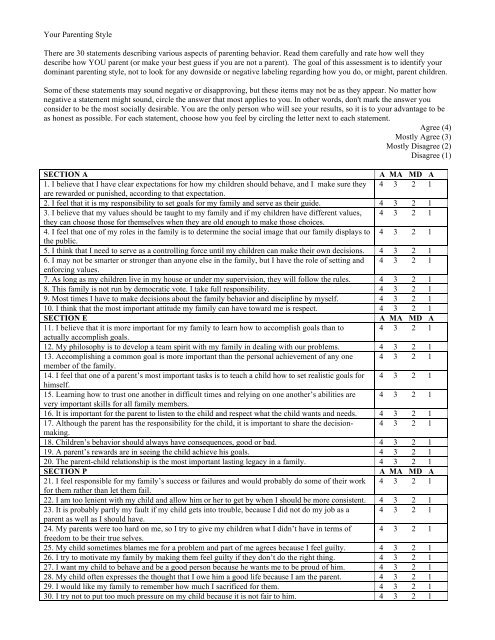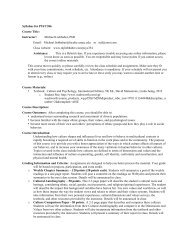Your Parenting Style There are 30 statements describing various ...
Your Parenting Style There are 30 statements describing various ...
Your Parenting Style There are 30 statements describing various ...
Create successful ePaper yourself
Turn your PDF publications into a flip-book with our unique Google optimized e-Paper software.
Scoring the <strong>P<strong>are</strong>nting</strong> <strong>Style</strong>sAdd up your totals for each section separately and write them here:A: _____ (Questions 1-10)E: _____ (Questions 11-20)P: _____ (Questions 21-<strong>30</strong>)Circle the meaning of your score in each of the three categories below:Section A: Authoritarian33–40 High identification with the Authoritarian style25–32 Dominant behaviors for the Authoritarian style18–24 Average or moderate behaviors for the Authoritarian style10–17 Low behaviors for the Authoritarian styleSection E: Equalitarian<strong>30</strong>–40 High identification with the Equalitarian style23–29 Dominant behaviors for the Equalitarian style15–22 Average or moderate behaviors for the Equalitarian style10–14 Low behaviors for the Equalitarian styleSection P: Permissive34–40 High identification with the Permissive style27–33 Dominant behaviors for the Permissive style18–26 Average or moderate behaviors for the Permissive style10–17 Low behaviors for the Permissive styleREAD ME: The labels of Authoritarian and Permissive may sound judgmental or negative to you. I want to emphasize thatthis interpretation is not accurate. An Authoritarian p<strong>are</strong>nt is not synonymous with dictator or controlling and should not beconsidered a negative or toxic style of p<strong>are</strong>nting. This style is simply more directive and tends to problem-solve by takingprimary control of a situation. In fact, using this style, you can achieve a high standard of compliance, as long as youapproach your child in a loving, caring manner. The Authoritarian style of p<strong>are</strong>nting is effective in another way too: Itprovides the important ingredient of structure, which is needed by many children.A Permissive p<strong>are</strong>nt is not synonymous with passive, lazy, uninvolved, neglectful or wishy-washy. Nor is this stylecharacterized by the type of p<strong>are</strong>nt who says to his kids, “Sure, go ahead and drink with your friends.” In reality, thePermissive style actually requires more effort on the part of p<strong>are</strong>nts because they must instill a greater degree of selfdeterminationin their children in order to get results. This approach is based on the familiar proverb, “If you give a man afish, you feed him for a day. If you teach him to fish, you feed him for a lifetime.” <strong>There</strong>’s a lot of truth in those words, asthey apply to the Permissive style of p<strong>are</strong>nting. It is this style that does one of the most effective jobs of imparting skills,values and self-worth in children and ultimately empowers them to make responsible choices and decisions. For p<strong>are</strong>nts usingthis style, their interactions with their child often involve more trial and error, as well as more words spoken. But it is timeand effort well invested in promoting the maturity and self-responsibility of their children.Everything related to p<strong>are</strong>nting styles depends on the type of child you’re managing, which we will assess a bit later in thischapter. Sometimes, the Authoritarian style is best and is the only style that gets results with certain children and in certainsituations. Sometimes, the Permissive style works the best of any style. So if your dominant style is either of these, pleasedon’t judge yourself; both styles can be acceptable and effective.Description of each p<strong>are</strong>nting typeAuthoritarianEqualitarianIf you scored in the dominant-to-high range in Section A, your dominant p<strong>are</strong>nting style tends to beAuthoritarian. This p<strong>are</strong>nt tells a child what to do and what not to do; the rules <strong>are</strong> clear and usuallyinflexible. It would not be surprising to find that an Authoritarian p<strong>are</strong>nt controls most of the decisionmakingprocesses in his or her family. Using the Authoritarian style, a p<strong>are</strong>nt sets family goals, gives therewards and handles the punishment—and does so sensitively and usually not in an arbitrary fashion. <strong>There</strong>is absolutely no ambiguity in terms of what is expected, who does what in the family or how misbehaviorwill be disciplined. The Authoritarian style tends to be confrontational at times.Scoring in the dominant-to-high range in Section E indicates that you tend to use the Equalitarian stylewhen p<strong>are</strong>nting your children. You give your children a role in making choices; your family operates like ateam, and decisions <strong>are</strong> made somewhat democratically up to a point. <strong>Your</strong> entire family is involved ingoal-setting, decision-making and problem-solving, and there is usually an atmosphere in your family of
SummaryPermissiveeffective communication and team spirit. The Equalitarian style of p<strong>are</strong>nting is usually successful atnegotiating compromises.A p<strong>are</strong>nt using the Equalitarian style believes in giving children choices. Children in these families learnthat their opinions and thoughts count. Rules in the household <strong>are</strong> simple, with reasonable consequences forbreaking them, and children understand the reasons behind the rules. <strong>There</strong> is room for flexibility, however.If a child’s bedtime is 8:<strong>30</strong> P.M., it might be extended if there is a special show on television they want towatch. Generally, a p<strong>are</strong>nt using this style is responsive, attentive and sensitive to children’s needs.Discipline is viewed as an opportunity for a teachable moment.If you scored in the dominant-to-high range of Section P, yours is a Permissive style of p<strong>are</strong>nting. Yougenerally take a more gentle approach, intervening only when your kids get off track or into trouble. Youkeep your children within broad boundaries, plus work to make everything seem as if it were your child’sidea in order to give a lot of ownership.Adopting this style, you act compassionately, empathetically, and encouragingly. You have the ability totap your children’s internal motivations, such as need for self-improvement, more personal goal attainmentor even guilt. As a result, you know how to push the right buttons to motivate your child in the rightdirection. Many great inventors and sports figures had permissive mothers who maintained this primarypattern, including Lance Armstrong, Thomas Edison and Albert Einstein.Permissive p<strong>are</strong>nts generally encourage freedom of expression so as to enhance their children’s creativityand allow them to voice their opinions.You may have scored in the high-to-dominant range of one of these p<strong>are</strong>nting styles, meaning that there is adominant theme of Authoritarian, Equalitarian or Permissive p<strong>are</strong>nting running through your behavior. Or you mayhave scored high on each and every style dimension. That’s a good thing, really; it means you have a well-developedrange of styles. If you <strong>are</strong> high in one dimension and low in another, you need to recognize that you may need tomake a conscious decision to step up and lead more effectively when it is called for, even if it means using the stylewith which you have the most difficulty.What your score can also tell you is how people, including your children, may perceive you, based on your style ofinteracting with them. Given a dominant score in any of these styles, it is very likely that others perceive you ashaving certain traits, some may be reacted to negatively and some may be reacted to positively. These <strong>are</strong> listed inthe table below. The aggregate of these traits is what defines your children’s reactions to you, and therefore, yourrelationship with them. If you don’t understand why your children react to you the way they do, it may be becausethey <strong>are</strong> simply responding to one or more of these traits. If that’s the case, begin consciously, purposely andactively changing your style to improve your interactions with your family.Adjectives that describe each p<strong>are</strong>nting styleAUTHORITARIAN EQUALITARIAN PERMISSIVE• Decisive • Collaborative • Accepting• Requiring • Team player • Supportive• Efficient • Sharing responsibility • Respectful• Assertive • Decision maker • Open• Task-oriented • Not bossy • Agreeable• Controlling • Ingratiating • Assuring• Strict • Avoiding leadership • Conforming• Rigid • Undisciplined • Motivating from behind the scenes• Inflexible • Reactive • Pushing the child on self-goals• Domineering • Manipulative • Relying on internal structure• Too lenient• Too time-consuming





